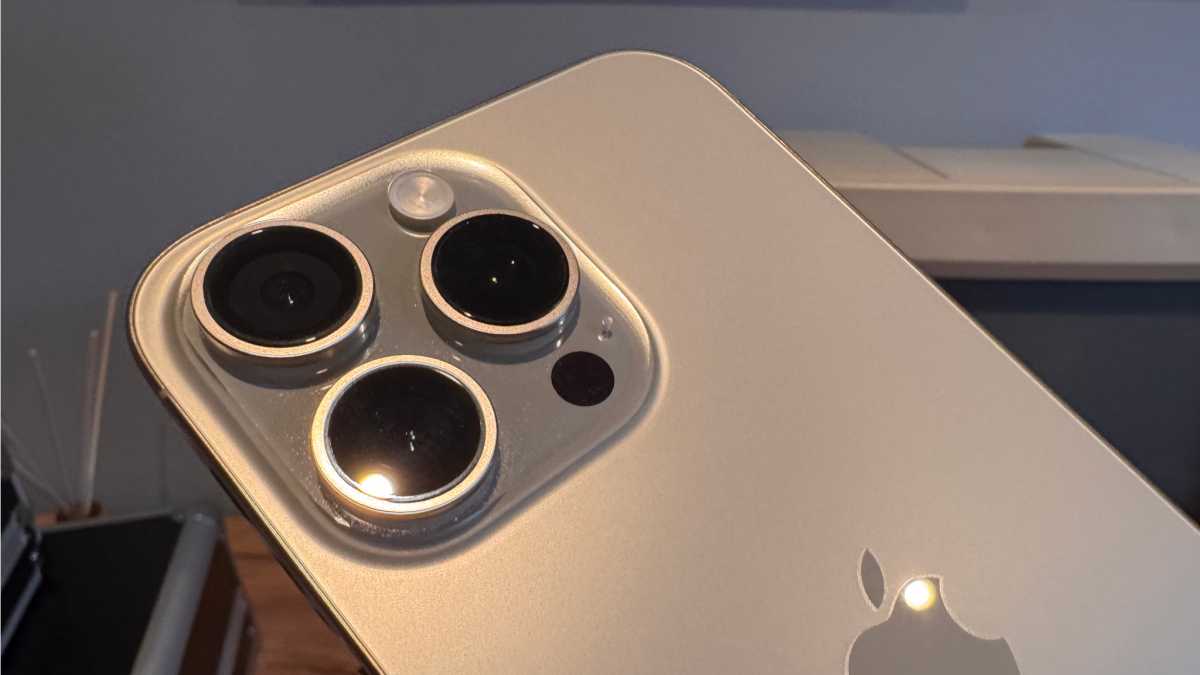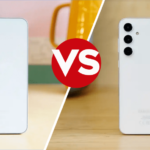Expert’s Rating
Pros
- Stunning 6.9-inch display with ultra-thin bezels
- Premium design and build
- Powerful A18 Pro chipset
- Excellent battery life
- Useful Camera Control button
Cons
- Incomplete AI features at launch
- Only 8GB of RAM at launch
- Big and heavy
- Expensive
Our Verdict
The iPhone 16 Pro Max looks almost identical to the iPhone 15 Pro Max, aside from slimmer bezels and one new button. But for real change, you must look within, with excellent performance, great battery life and a slew of AI features on the way, even if most aren’t available at launch. There’s no doubt that this is one of the very best phones you can buy, though it has a price tag to match.
Price When Reviewed
This value will show the geolocated pricing text for product undefined
Best Pricing Today
Price When Reviewed
1099
From the outside, the iPhone 16 Pro Max only looks like a minor refinement of its predecessor – especially with the design largely unchanged.
But, with its 6.9-inch display and titanium body, it’s bigger, heavier, and ever-so-slightly more robust than the iPhone 15 Pro Max. And, of course, there’s the new Camera Control button, which yes is a physical button.
Spend some time with Apple’s latest flagship, and you’ll notice several changes (mostly on the inside) that significantly impact how you’ll use the device, especially if you’re into photography or the latest AI features.
While the A18 Pro chip makes this phone a raw performance beast, Apple has put a lot of its future into Apple Intelligence – its answer to AI. The addition of the Camera Control button and upcoming Visual Intelligence capabilities also speaks to Apple’s ambition to redefine how we interact with the world through our phones.
Design & Build
- Noticeably thinner bezels
- Titanium build is premium, durable, and aids in heat dissipation
- Camera Control button is innovative but questionable
The iPhone 16 Pro Max maintains Apple’s recent design ethos, making only slight adjustments. It’s a premium-looking device, and its rounder corners and Natural Titanium colour option were clear influences on the Pixel 9 lineup.
This year’s new colour option is Desert Titanium, the goldish hue that has divided the internet. While the phone looks almost identical to the iPhone 15 Pro Max at first glance, there are some differences.
Thinner bezels around the screen make the already huge display feel even more expansive. Despite the display growing to a massive 6.9 inches, Apple has managed to keep the device almost the same size as last year’s model, making it feel like you’re holding more screen than phone.
The Super Retina XDR OLED panel now stretches further into the corners, creating a more immersive visual experience for both gaming and media consumption.
The titanium body, a grade 5 titanium frame over a graphite-clad aluminium substructure, has been further refined this time around. It gives the device a premium feel while also improving heat dissipation. The edges of the iPhone 16 Pro Max have been softened, making it more comfortable to hold for extended periods despite its larger size.

Connor Jewiss / Foundry
At 6g heavier than the iPhone 15 Pro Max, I didn’t notice much difference in handling. However, if you’re used to regular phones, this 227g handset might come as a shock.
The larger display size is also immediately evident. For me, it strikes the perfect balance between weight and build quality – this is a phone that feels robust but not bulky.
One new addition I appreciate is the Camera Control button, which Apple insists isn’t quite a button – but it is. It sits recessed, offering gesture control and a quick launch to the camera, much like the Action button introduced last year.
For me, the iPhone 16 Pro Max strikes the perfect balance between weight and build quality
I’ll talk more about the Camera Control later, but will share some early thoughts now. While I found the Camera Control useful for photography, it sometimes competes with the Action button for relevance. Apple may need to rethink the function of the older Action button in future iterations, as it feels underused compared to this newer control.
Screen & Speakers
- 6.9-inch Super Retina XDR OLED with 120Hz
- Great outdoor visibility with 2000 nits of peak brightness
- Stereo speakers provide clear, loud sound with decent bass
This 6.9-inch Super Retina XDR OLED display is Apple’s largest yet, and it’s a beauty. The thinner bezels allow for more screen real estate without significantly increasing the device’s physical size.
At 460ppi, the display isn’t as pixel-dense as the Samsung Galaxy S24 Ultra (505ppi), but Apple’s colour accuracy and HDR performance make it hard to notice any shortcomings. Apple has maintained its wide-color gamut, meaning colors are incredibly vibrant, yet remain natural and true to life.
With 2000 nits peak brightness outdoors and a new 1 nit low setting for nighttime use, it’s easy to see why this is one of the best displays on the market. Whether I’m streaming Netflix or playing a game, the visuals are vibrant and smooth, thanks to ProMotion’s 120Hz refresh rate. And the new support for 1 nit of brightness comes in particularly handy when using my phone in bed at night.

Connor Jewiss / Foundry
This 6.9-inch Super Retina XDR OLED display is Apple’s largest yet, and it’s a beauty
The 1 nit support still extends to the Always-On Display, letting you check notifications, time, or other widgets without fully unlocking the phone. It also dims intelligently to save power when not in use. While I personally don’t use the Always-On Display, it is a hit feature after being introduced a few years ago.
Then we get to the stereo speakers. While not dramatically improved from the previous model, the iPhone 16 Pro Max still offer loud, crisp sound with decent bass. For a phone this size, it’s a surprisingly capable audio device.
Specs & Performance
- Powered by the A18 Pro chipset – up to 20% faster than last year
- Great for gaming and multitasking
- 8GB RAM is low compared to competitors, but performs well due to optimisation
Powering the iPhone 16 Pro Max is Apple’s latest and greatest A18 Pro chipset, which is a significant step up from the A17 Pro, particularly when it comes to AI performance and graphical power.
According to Apple, it has a 15% faster CPU and 20% faster GPU than last year’s model. I can’t verify those figures but can say that it offers blisteringly fast performance across the board. That applies whether you’re editing 4K video, running the latest AAA mobile games, or simply multitasking between apps.
It also comes equipped with a 16-core Neural Engine, enabling more advanced machine learning and AI capabilities. It’s a big factor in making these devices capable of the full range of Apple Intelligence features, which I’ll explore in more detail later.
Gaming enthusiasts will be pleased to know that the iPhone 16 Pro Max supports ray tracing at double the speed of the A17 Pro, which makes for more realistic lighting and reflections in games available on iOS. During my tests, the device handled everything I threw at it, from graphically intensive games like Death Stranding to video editing on Adobe Premiere Rush.
The A18 Pro breezed through it all without a hiccup, though the device did get a bit warm after extended gaming sessions. However, it was noticeably less warm than the iPhone 15 Pro Max.
For an extra test, I set both phones to record 4K videos for around 30 minutes. Then, using a laser thermometer, I recorded how warm both devices got over the area where the processor sits. The iPhone 16 Pro Max was between 3-4c cooler than the 15 Pro Max.
While competitors like the Samsung Galaxy S24 Ultra and Google Pixel 9 Pro XL offer up to 12GB of RAM, Apple sticks with 8GB in the iPhone 16 Pro Max. However, Apple’s custom optimization ensures the device runs incredibly smoothly, even when handling demanding tasks or multitasking. Storage options start at 256GB and go all the way up to 1TB, providing plenty of space for apps, games, photos, and videos.
Apple iPhone 16 Pro Max benchmarks
There’s no denying that the iPhone 16 Pro Max is an absolute powerhouse. It delivers all the performance you could want and more. In fact, it actually clocks up higher Geekbench 6 scores than the M1 MacBook Air from late 2020 – with 3518 for single-core and 8378 for multi-core.
I was impressed with how snappy and responsive everything felt, from multitasking to gaming and watching content. There’s absolutely nothing I could do that would cause this device to freeze up, slow down, or begin to drop frames.

Connor Jewiss / Foundry
The iPhone 16 Pro Max outperforms both the Samsung Galaxy S24 Ultra (Snapdragon 8 Gen 3) with 2,273 single-core and 7,056 multi-core, and the Google Pixel 9 Pro (Tensor G4), which scores 1,950 single-core and 5,950 multi-core. The raw power inside the iPhone 16 Pro Max is simply unmatched.
There’s no denying that the iPhone 16 Pro Max is an absolute powerhouse. In fact, it actually clocks up a higher Geekbench score than the M1 MacBook Air
Cameras
- 48Mp main camera, 48Mp ultrawide, 12Mp 5x telephoto
- Camera Control button offers gesture-based camera controls
- 4K 120fps slow-motion video, and new AI audio features
Apple has always placed a strong emphasis on photography, and the iPhone 16 Pro Max is no different. While the camera specs may seem familiar, Apple has introduced some major hardware and software upgrades that make this one of the most powerful camera systems available.
The 48Mp Fusion camera and 48Mp ultrawide camera are the stars of the show here. Apple has upgraded the sensor behind the main camera, enabling faster autofocus and improved low-light performance. Even in challenging lighting conditions, the iPhone 16 Pro Max captures impressive detail without oversaturating colours or introducing noise.
The ultrawide lens, which has been upgraded to 48Mp for the first time, offers sharper, clearer photos at wide angles. This is particularly useful for landscapes, architecture shots, or group photos. The improved macro capabilities also stand out, making it easier to capture tiny details without sacrificing quality.

Connor Jewiss / Foundry
The 12MP telephoto camera with 5x optical zoom also features so-called tetraprism technology, which helps to ensure minimal distortion, even at higher zoom levels. While this was exclusive to the iPhone 15 Pro Max last year, this time around it is also available on the smaller iPhone 16 Pro.
I found the zoom performance to be excellent, especially when taking photos of distant subjects, where the image stabilisation helped keep everything crisp and steady. Compared to competitors like the Samsung Galaxy S24 Ultra, which offers a higher zoom range, the iPhone still holds its own with superior colour accuracy and dynamic range.
However, I do wish the telephoto lens got the higher-resolution upgrade as well. Xiaomi’s recent Mix Flip foldable ditched the ultrawide lens that the Galaxy Z Flip 6 and others use in favour of a telephoto – simply because more people use the zoom lens. I think the same is true of iPhones. Perhaps we’ll see a more significant upgrade on iPhone 17 Pro Max?
Even in challenging lighting conditions, the iPhone 16 Pro Max captures impressive detail without oversaturating colours or introducing noise
You’ve got plenty of other modes to pick from as well. Portrait shots come out looking exceptionally natural and sharp, with detail and sharpness being retained when you zoom in. This is true for both the rear camera and selfie snapper. The night mode is downright exceptional, with the image processing usually opting for more realistic colour in substitution for extra sharpness.
If you’re hoping to just point and shoot your photos, the iPhone’s camera app is arguably the best for this. And with faster apertures on all of the cameras, taking shots is quicker than ever – something you can really notice if you’re trying to capture something that’s moving or want to take lots of back-to-back snaps.
One of the most exciting additions is the Camera Control button. This touch-sensitive control lets you access various camera modes with gestures. While it took some getting used to, I found it incredibly useful when shooting on the go – especially when I was doing activities or only had one hand free. You can adjust zoom and depth of field or even switch lenses without ever tapping the screen.
Of course, you can still do all this from the screen. And when you’re taking photos ordinarily, it might actually be easier to not use Camera Control. My other big gripe with this is that when your iPhone is switched off, you’ll have to press the button twice to launch the camera. Pressing it once will switch your device on first.
Visual Intelligence looks compelling as a Google Lens alternative, but this isn’t available at the time of writing (even on the beta software I was running).

Connor Jewiss / Foundry
The iPhone’s video capabilities have also been supercharged with 4K 120fps recording and Dolby Vision. I shot some slow-motion footage at 120fps, and the results were breathtakingly smooth.
Apple has even introduced AI-powered Audio Mix tools, which are especially useful when editing on the fly. Whether I was editing clips for social media or more professional use, the mix of cinematic video and studio-quality audio tools made the iPhone 16 Pro Max a true media powerhouse. The noise reduction doesn’t work quite as well as I’d have hoped, but is definitely better than not being there at all.
Battery Life & Charging
- Long-lasting battery life of 14-16 hours with typical use
- Apple has stayed quiet on the mAh number
- Faster MagSafe charging and Qi2 support
Apple has significantly improved the battery life in the iPhone 16 Pro Max, thanks to both hardware and software advancements. Even with the larger 6.9-inch display, the battery life is excellent, and I consistently got 14 to 16 hours of regular use on a single charge.
In fact, when trying to deplete the battery in order to test the charging speeds (see below), I actually found it difficult to run the battery down to 0. A combination of gaming, filming, and gaming managed to do the trick – but it was no easy feat.
Of course, Apple won’t tell us the exact mAh figure of the battery, though GSMArena estimates it to be 4685mAh. However, the brand does claim that this is the biggest battery ever seen in an iPhone. So far, that seems true, and my results line up with Apple’s estimates.

Connor Jewiss / Foundry
This all-day battery performance is primarily due to the power efficiency of the A18 Pro chip, which optimises power consumption during less demanding tasks. Whether I was streaming video, using GPS for navigation, or taking photos throughout the day, the phone easily made it to the evening with battery to spare.
Apple has also enhanced MagSafe charging, which is now faster than ever before. Apple claims the phone can charge up to 50% in 30 minutes using a 30W charger, which is impressive for a battery of this size. In my testing, it beat that, getting from 0-50% in 28 minutes. Also, this year the USB-C port has been bumped up to Thunderbolt 4, enabling faster data transfer.
It also supports Qi2 wireless charging, making it future-proof as more third-party charging pads adopt this new standard. Though USB-C is now standard for charging, the iPhone 16 Pro Max can also be used to charge other devices, like AirPods or an Apple Watch, through reverse wireless charging.
When trying to deplete the battery in order to test the charging speeds, I actually found it difficult to run the battery down to 0
Software & Apps
- Apple Intelligence shows huge potential, but isn’t available at launch
- New iOS 18 features like Math Notes and AI Writing Tools are useful
- Impressive seven years of software support
The iPhone 16 Pro Max ships with iOS 18 out of the box. And while Apple is leaning heavily into AI with its Apple Intelligence features, you don’t get these out of the box.
The first of these be coming in iOS 18.1 – software that’s currently available for the public to download in beta ahead of an October launch. However, many of the most anticipated AI features won’t be fully available until future updates even further down the line, making the software experience feel like it’s in transition.
For this review, I did install the iOS 18.1 beta to test Apple Intelligence, as anyone can do the same. Ordinarily, I’d say you can’t review what’s not on the device. But, since anybody can technically get Apple Intelligence, I will include it in the review.
The advertisement of Apple Intelligence but exclusion of the features out of the box is disappointing to see from Apple
Just note that you won’t get any Apple Intelligence features out of the box, while only the features I mentioned below are confirmed for an October release. Rumours suggest the rest of the features should have finished rolling out by February/March next year, but Apple has not confirmed this.
The advertisement of Apple Intelligence but exclusion of the features out of the box is disappointing to see from Apple. The brand is known for releasing features a little later than the competition, but often does things even better than rivals. Apple Intelligence is hailed as the iPhone 16 line-up’s core feature, but it’s not here yet, which makes the marketing feel disjointed.
For example, in the Apple store, demo iPhone 16 models show the new Siri UI in promotional reels. But if you actually use Siri, the old interface appears. Things feel rushed, and that’s not like Apple.

Connor Jewiss / Foundry
Siri has received a significant overhaul, becoming more responsive and conversational. In beta, the new design takes over the entire screen when activated, providing a more immersive experience.
Siri is now better at handling multi-step requests and retaining context between interactions, which makes it feel more like a true assistant rather than just a voice command system. This context will get even deeper in later updates, which will also include ChatGPT integration.
Writing Tools within apps like Mail and Messages use AI to help improve the tone and clarity of your writing, offering suggestions on making your text more professional or concise.
You also get notification summaries, which pick the key points out of notifications from any app so you don’t have to read the full thing. These work surprisingly well, and might be the best implementation of AI on a phone. There’s a ‘Reduced Interruptions’ focus mode, which restricts notifications to only the ones Apple thinks are most important.
Features like Genmoji, the Image Playground, ChatGPT integration, and the full Siri upgrade are unavailable. But there’s plenty new in iOS 18 beyond Apple Intelligence.
iOS 18 introduces useful features like Math Notes, which lets you solve equations directly in the Notes app by writing them out. There’s also the ability to further customise your app icons, including the option to leave blank spaces in your home screen’s app grid for more personalized layouts, something iPhone users have been asking for.
Apple doesn’t explicitly say how long the iPhone 16 Pro Max will be supported for, but if previous models are anything to go by, it’ll probably continue receiving updates for at least seven full years. That matches the very best on any Android phone, and might even be extended when we get closer to the time.
Price & Availability
As expected with a flagship iPhone, the iPhone 16 Pro Max comes with a premium price tag. Starting at £1,099/$1,099 for the base model with 256GB of storage, it’s the same price as last year’s model, but with added features.
The 512GB version costs £1,399/$1,399, while you’ll pay £1,599/$1,599 for 1TB of storage.
The phones are available outright from Apple UK and Apple US, but also via a range of third-party retailers. See the full range of options in our guide on where to buy the iPhone 16 series.
That article includes contract options, but many of the most affordable options are included in the widgets below.
Should you buy the iPhone 16 Pro Max?
The iPhone 16 Pro Max builds on what Apple does best – elegant design, powerful performance, and excellent cameras.
The introduction of Apple Intelligence and the Camera Control button makes this phone especially appealing to photographers and those interested in AI-enhanced functionality. The 6.9-inch Super Retina XDR OLED screen is the best Apple has ever produced, while the A18 Pro chip ensures that the phone is future-proof for years to come.
However, the full potential of Apple’s AI features is not yet available, and with many features not launching until later in the year, some users may want to wait.
Ultimately, if you need an iPhone that pushes the boundaries of photography and performance, the iPhone 16 Pro Max is an excellent choice. But it’s also a very expensive one.
Specs
- iOS 18
- 6.9-inch 2868×1320 460ppi Super Retina XDR display
- A18 Pro chipset
- 8GB RAM
- 256GB/512GB/1TB storage
- 48Mp f/1.8 main camera
- 48Mp f/2.2 ultrawide camera
- 12Mp f/2.8 5x telephoto camera
- 12Mp f/1.9 front camera
- 4685mAh battery (reported)
- USB-C fast PD 2.0 charging
- 25W wireless MagSafe charging
- 15W wireless Qi 2 charging
- 4.5W reverse wireless charging
- Wi-Fi 7
- Bluetooth 5.3
- 5G
- IP68 water and dust resistance
- 163 x 77.6 x 8.3 mm
- 227g
Read the full article here











